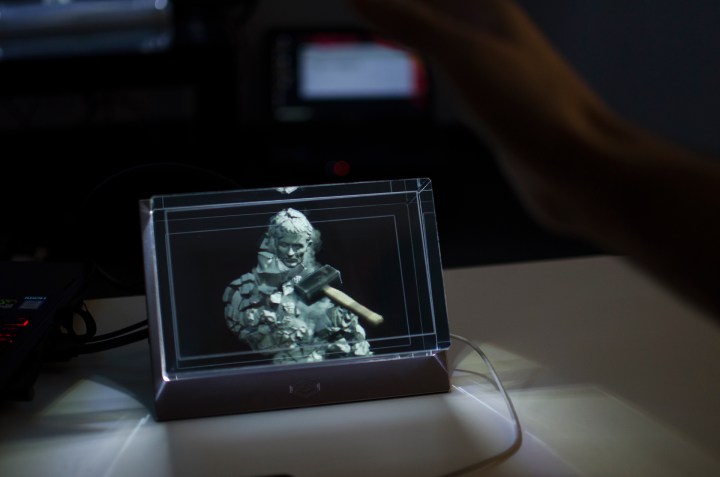.gif)
There are several reasons why 3D televisions failed, and one of them was the lack of 3D content. Well, there’s a new 3D “holographic display” in town — the Looking Glass — and the company behind it is following quite a different strategy. Instead of delivering content-less hardware to consumers, the Looking Glass is designed by and for 3D creators, and you’ll soon be able to find compatible videos on Vimeo.
Looking Glass Factory is a Brooklyn-based company founded in 2013 that has been tinkering with hologram technology for the past five years. It has produced and sold several products in that time, including L3D cubes, the Looking Glass Volume, and the HoloPlayer One, but it’s clear everything has been leading up to the new Looking Glass.
The Looking Glass is a heavy glass box that’s available in 8-inch and 15-inch sizes. It can display 3D holographic content — which looks like it’s floating in air — and you don’t need any kind of headset for it to work. It’s meant to sit on a desk because it needs to be connected to a relatively powerful PC or laptop.
We had a chance to check it out, and we can easily confirm the Looking Glass produces the most lifelike 3D content we’ve ever seen. Animations ported into the Looking Glass — an easy process since the platform supports Unity — are fluid, and they look sharp from various angles. You can also interact with the holographic interface, as the Looking Glass supports a variety of peripherals such as the Leap Motion Controller, and even the Nintendo Switch Joy-Con controllers.
The idea is to get the Looking Glass into the hands of 3D creators around the world.
We tossed around an animated dancing figure with just our hands with the aid of the hand-tracking Leap Motion controller, and we also lit up a scene of a frog with our finger acting as a torch.
The idea is to get the Looking Glass into the hands of 3D creators around the world. These creators can then see what their creations look like through this holographic display, which can in turn help influence the design process. For example, pulling a 3D model into the Looking Glass and then casting artificial light to it can help animators see exactly where the shadows land.
This will eventually lead to creators populating a 3D App Library, which currently houses dozens of apps from Looking Glass Factory. Once there’s plenty of content, co-founder and CEO Shawn Frayne told Digital Trends consumers will follow — they’ll want the Looking Glass in their homes.
That push for more content is being helped by a new partnership with Vimeo. Looking Glass Factory has teamed up with Vimeo’s Creator Labs to offer Looking Glass owners even more content through a Vimeo app. The app will allow creators to record and capture Looking Glass holograms, which will then be able to be uploaded to Vimeo’s servers and streamed to a Looking Glass.

“It’s one of our theories that a few years from now in people’s homes, they do have several Looking Glasses, in each of their rooms, that have an Alexa or some other voice A.I. running with it,” Frayne said. “There’s a virtual character that speaks with the voice of Alexa, and then she or he will bring up anything you ask for. In that sense, it would start to become a centerpiece of media and communication and creation in the home.”
How it works
The Looking Glass is made up of a combination of light-field and volumetric display technology. The light-field display re-creates the rays of light that bounce off the 3D content, which helps you visualize it, and the volumetric display helps create these animated objects in three dimensions.

Frayne said the Looking Glass generates 45 views of 3D content, so a group of people can huddle around the device and see the scene without any problems. We didn’t find ourselves feeling any eye strain or nausea after staring at the Looking Glass for quite some time.
With these holographic objects, Frayne believes we will see more data, and that our brains will prefer this presentation over standard 2D screens. For example, looking at map data of Mars through the Looking Glass will provide a better understanding of the terrain than if we simply looked at the information on a 2D screen.
“The hope is that at first people get the system because the content feels more alive.”
“The hope is that at first people get the system because the content feels more alive, and then they realize, ‘Oh I can design my characters faster and better in this system,'” Frayne said. “Then it’s this virtuous cycle of the designers creating new media for this system, and then people consuming that and enjoying it and learning from it.”
The Looking Glass starts at $600 for the smaller 8.9-inch version, but the price jumps up to $3,000 for the larger 15.6-inch model. Early adopters were able to grab them for deeply discounted prices through Kickstarter, with about 100 units shipped in September — while later orders will follow in December. If you didn’t grab the Kickstarter bargain in time, you can still grab a Looking Glass through Looking Glass Factory’s website, where the smaller model’s $600 price has been discounted to $499.
2018 has been a great year for holographic displays. RED, the company behind professional video cameras, brought out its smartphone with a holographic display, and while a disappointment as a phone, it’s a great indication for future tech.
Updated on November 1, 2018: Vimeo and Looking Glass Factory have announced a Vimeo app that will bring even more holographic content to the Looking Glass.






